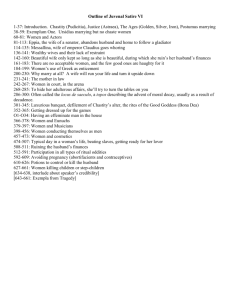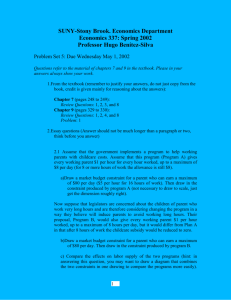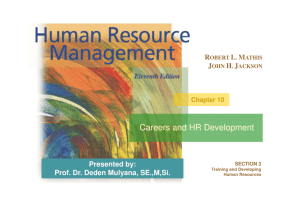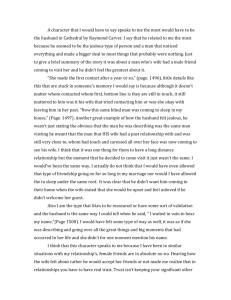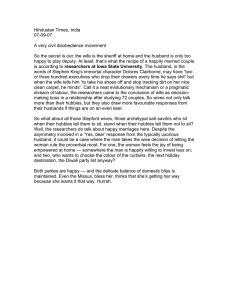WOMEN IN ACCOUNTING: Linda Hogan Thesis Director
advertisement
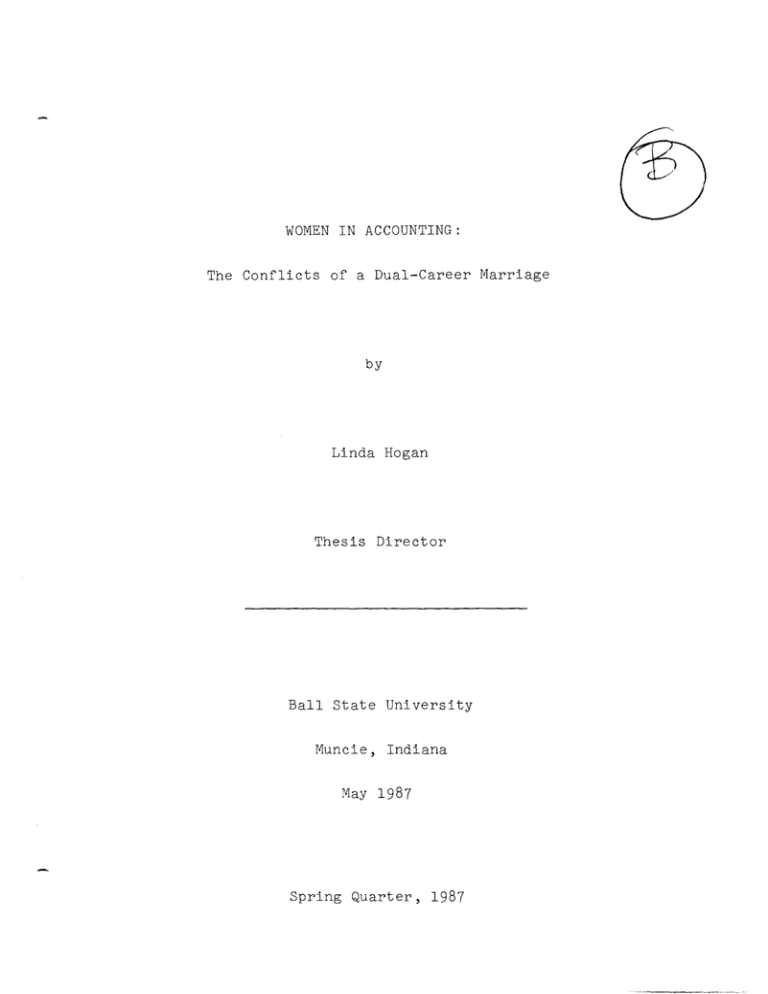
WOMEN IN ACCOUNTING: The Conflicts of a Dual-Career Marriage by Linda Hogan Thesis Director Ball State University Muncie, Indiana May 1987 Spring Quarter, 1987 ! ~. h ~ . . Hc~ Twenty years ago, it might have been considered unnatural for a young woman to graduate from college as an accounting major. today more and more women are doing exactly that. actually the place for women to be now. But, Accounting is Women who like the challenge and who take on the work, especially in public accounting, do well today. In fact, females now represent 55 to 60 percent 1 of the hiring pool for major firms. This h~ring rate of women points to the possibility of female domination of the profession in the future. Not only are the numbers of women accountants growing, but their influence on the profession is growing as well. Women are making greater strides at younger ages, maintaining more prestigious positions, and being compensated financially for their 2 performances. Therefore, women graduates of the class of 1987 and subsequent years will have an easier time of it in accounting than their predecessors. Although women accountants will have an easier time of it professionally, their personal lives may be a different story. Those that choose to have it all, a family as well as a career, have a complex set of problems to deal with. These women are part of a relatively new phenomenon known as the dual-career marriage. A du~l-career marriage is defined as one in which both partners work in positions that require specialized education or training. Before women began winning equal time in the college and professional worlds, the problems associated with a dual-career marriage were rarely confronted. dramatically. Today, the situation has changed The American Woman's Society of Certified Public 2 Accountants in its latest survey of 12,000 members, found that 66 3 percent of women CPAs are part of two-career families. Moreover, many of this year's accounting graduates will marry other young professionals who will earn as much and consider their careers just as important, according to recent United States Labor Depart- 4 ment Statistics. There is no question that the rewards of sharing career, achievement, and childrearing with one's spouse are great, but the price paid can be high. Many young couples are not prepared for this. Studies on dual-career families have uncovered some common areas of conflict. These conflicts seem to fall into two categories. Those that are professional in nature and those that relate to the home. The professional conflicts seem to hinge on the success of one of the partners. For example, salaries are often a source of conflict in dual-career marriages. Some men have trouble accepting the fact that their wife earns more money than they do. This is because status and career value are largely dependent on earning power. The person who brings home the higher salary is usually considered the head of the household. been the husband. Traditionally, this has To some men, degrees, honors, and accomplish- ments are not as important as the dollar amount of the paycheck. 5 Another aspect of this problem is the concept of "her earnings." Society has placed a lesser value on the wife's paycheck than on the husband's. this idea. Bank and government agencies have even reinforced Young married couples are often advised to "live off 6 his income and bank hers." Couples theQselves even carry out and encourage this idea in the way they deal with paying the bills. Many couples will have 3 - the "important" bills, such as the mortgage payment and car payments come out of the husband's paycheck and the lesser household bills coming from hers. Job promotions can also create a crisis for the family when both partners have careers. What should be a happy occasion usually turns out to be something quite different. If one partner is jealous of the other's success, a promotion can aggravate and in- 7 tensify these feelings. This is especially true of couples who are employed in the same field. An example in the public account- ing field would be a husband who was jealous because his wife rose to the partnership level before he did. In addition, if a limited number of positions are available in the field, these feelings are further intensified. When the husband is offered a promotion which involves moving to another city, the wife's career can be harmed. has been expected to make this sacrifice. ordinarily do the same for their wives. In the past, she However, men do not Many are afraid people, especially other men, will think less of them if they move in order to benefit their wife's career. One person's career frequent- ly suffers when a move is made that benefits only one of the partners. An example of this situation happened recently to a woman who was employed by the public accounting firm I will be employed by following graduation. She moved with her husband to a small town in another state after he received a promotion. However, she was unable to find a position comparable to the one she left behind. - Therefore, her career has suffered a setback as a result of her husband's promotion. Since it is evident that the career advances of one person can handicap the career opportunities of the other, 4 making fair and equitable decisions is important. Other professional conflicts become evident in a couple's social life. When a woman is well known to other people, her husband may feel overshadowed by her success. Unless hE- is secure himself, conflicts will almost certainly develop. This is especially true when the couple is in the same field. For example, if both partners were accounta~ts a conflict could develop if the wife was asked to join a more prestigious firm than her husband. Many men have difficulty handling the idea of a successful wife in the same field. Some arE basically fearful of being overshadowed and embarrassed, and appearing less competent 8 than the female. But that is not the only social situation in which conflicts can develop. Professional lifestyles, combined with the family commitment, restrict the couple from having a lot of friends and 9 from doing a lot of socializing. Couples ~epeatedly have to cancel planned activities with friends because of work obligations. Tradeoffs must be made. Therefore, many eventually develop friend- ships with other dual-career couples who understand the situation. The second area of conflict for dual-career families involves the home. Changes in lifestyles and in family living patterns are often necessary in a family in which both the husband and wife have careers. Inherent in these changes are somewhat predictable difficulties which can be the source of family conflicts. The biggest area of conflict on the home front seems to be when the couple decides to have children. In the 1960's working women typically quit their jobs when they became pregnant. In the 1970's they often decided not to have children in order to devote more time to their careers. But in the 1980's, women are trying to have 5 10 it all. Female CPAs are no exception. Combining career, pregnancy and subsequently, children is very stressful. Tension is produced by such work related factors as: not knowing whether your job will be there when you return; facing temporary disability without income; and selecting quality child11 care. Typically, even though the woman has a full time career, she is still responsible for taking care of the children and the household chores. This causes many career women to be discontented with their home situation because they are expected to shoulder 12 all the responsibility for the care of the children and the home. Although office work is a priority, children still have to eat and have clean clothes for the next day. Occasionally this leads to the controversial issue of "who does what," especially when both parents have excessive career demands at the same time. is especially true of accountants during busy season. This Regardless, someone has to prepare the meals for the children and supervise preparation for bed and for the following day. Besides the daily care of the children, problems arise when a child becomes ill. Which partner should stay home with the child? Traditionally, it has been the mother. But, with both parents having important careers, this custom is unfair. Why should the wife have to be the one to sacrifice her career time and time again? Parents have the option to take turns in this situation but this is rarely the case. A major area of concern for couples with children is finding satisfactory childcare services. Childcare is the fourth largest expense for the working family, after housing, food, and taxes. 13 One couple, both with careers in accounting, spends between $800 6 14 and $900 a month for care of their two young children. The arrangements that are made must be reliable and flexible. If satisfactory care cannot be found, the alternative is to put one partner's career on hold so as to allow them to take care of the children. This could be very detrimental to that partner's career, if not disastrous. The partner that this affects is usually the wife. Problems may even develop with the children themselves. may not understand why both parents work. ~hey They may misinterpret 15 a parent's absence from the home as a sign of rejection. The child may feel as though the parents do not want to spend time with him or her. vital. As a result, communication with the child is An explaination of why both parents work is helpful in the child's understanding of the situation. The time management of daily routines frequently seems impossible for career women with families. The wife typically finds she does not have time to complete normal household duties such as cleaning, cooking, laundry, and grocery shopping. Without joint cooperative effort from both partners schedules are not kept and tasks are not accomplished. Men who are suddenly faced with actively participat- ing in activities such as babysitting, dinner preparation, laundry 16 or cleaning house sometime find adaptation difficult. In addition, the working mother often feels frustrated if the husband does not participate in these chores. The standard stereotyped division of labor with childcare and household chores is impractical when both the husband and wife have careers. Conflicts can be minimized if the responsibilities of childcare, meal preparation, and household chores are shared by the partners. However, the majority of households are not open to such changes in family roles. 7 Because of these family responsibilities, a woman may have to reject job assignments, out-of-town trips, promotions, or transfers. Women who combine both worlds experience obstacles that can block 17 Being aware of potential future professional and personal growth. obstacles can ease the conflict when it occurs. Women can then be more optimistic about the chances of successfully combining both worlds. In fact, some women have already successfully conquered this challenge. "The changes that occur when children come along can be traumatic, ~et it doesn't have to be," says Karen Stewart-Carrico, an accounting 18 professional from Nevada. She is married to a CPA who believes in the 50-50 concept of shared family responsibilities. It is important to adjust your expectations to reality and then be ready for a full commitment. Sally Thompson, a seven year Touche Ross veteran and former manager, says the question of commitment remains a major concern for new accountants, especially for those 19 who are married and are having families. this commitment is Deborah Douglas. Jne CPA who has made She is a mother who juggles office schedules with her CPA husband to cover the early morning 20 and late evening hours for three young children. These women illustrate the fact that it is possible to have it all. In addition, a survey has been done of several married account- ants in order to discover how their successful dual-career marriages operate. All of those interviewed have had to balance family and professional relationships. A common set of priorities emerges, regardless of work or geography. This set of priorities could promise success for others who might follow them. The study found that like any successful business partnership, the dual-career marriage demands commitment, understanding, and 8 participation on both sides. "It exemplifies mutual respect, compromise, sharing, self-confidence, tolerance, and communication. It also focuses logically on the family and its survival as the 21 foundation upon which any professional success must stand." Mutual respect for each other and, as a result, for each other's career, is the most important strength a marriage can have. woman does not have to make all of the sacrifices. The The partners have to be willing to compromise equally. There is no question that the rewards of sharing career, achievement, and childbearing with one's spouse are great, but the price paid can be high. Women who want both a career and a family should be aware of the difficult road that lies ahead. With advanced awareness, planning, and support, women are discovering that they can have successul careers and a family. Occasionally, however, a woman's choices place restrictions on her career. As long as women have the major burden of responsibility for the home and childcare, women will continue to decline career opportunities and, in essence, side track promising careers. ,- Notes 1 Susan Schiffer Stautberg, "Managing Childcare," New Accountant, October 1986, p. 10. 2 Sheri Arbital, "Women By the Numbers," New Accountant, October 1985, p. 29. 3 Jack B. Hayes, "Then There ~\Jere Two," New Accountant, October 1985, p. 19. 4 Arbital, p. 29. 5 Anne Russell and Patricia Fitzgibbons, Career and Conflict, A Woman's Guide to Making Life Choices (Englewood Cliffs, N.J.: Prentice-Hall, 1982), p. 129. 6 Ibid. , p. 129. 7 Ibid. , p. 130. 8 Ibid. , p. 13l. 9 Jack B. Hayes, p. 20. 10 Stautberg, p. 10. 11 Ibid. , p. 10. 12 Russell and Fitzgibbons, p. 125· 13 Stautberg, p. ll. 14 Hayes, p. 2l. 15 Russell and Fitzgibbons, p. 127. 16 Ibid. , p. 125. 17 Ibid. , p. 124. 18 Jack B. Hayes, "Taking Her Place," New Accountant, October _ 1986, p. 6. 19 Ibid., p. 8. 20 Ibid., p. 6. 21 Hayes, "Then There Were Two," p. 19. - Bibliography Arbital, Sheri. "Women, By the Numbers." New Accountant, October 1985, pp. 29-31. Gilbert, Lucia A. Men in Dual-Career Families: and Future Prospects. Hillsdale, N.J.: Current Realities Lawrence Erlbaum Associates, 1985. Hayes, Jack B. "Then There Were Two." New Accountant, October 1985, pp. 19-23. Hayes, Jack B. "Taking Her Place." New Accountant, October 1986, pp. 4-9. Messing, Janet. "Women In Accounting." New Accountant, October 1985, pp. 5-7,31. Rice, David G. Dual-Career Marriage. New York: MacMillan Publishing, 1979. Russell, Anne and Patricia Fitzgibbons. Career and Conflict, A Woman's Guide to Making Life Choices. Englewood Cliffs, N.J.: Prentice-Hall, 1982. Schenkel, Susan. Giving Away Success. New York: McGraw-Hill, 1984. Smith, Audrey D., and William J. Reed. Role-Sharing Marriage. New York: Columbia University Press, 1986. Stautberg, Susan Schiffer. "Managing Childcare." New Accountant, October 1986, pp. 10-14. -


